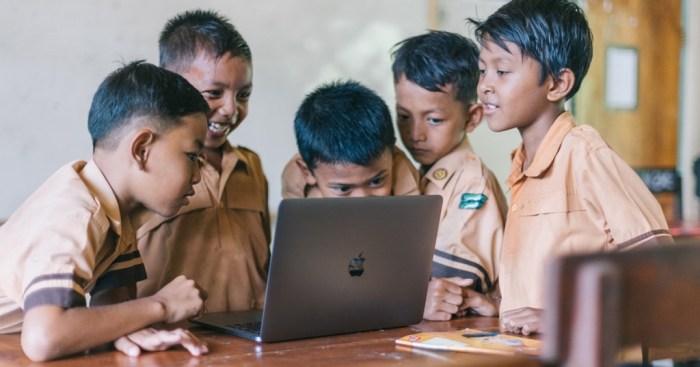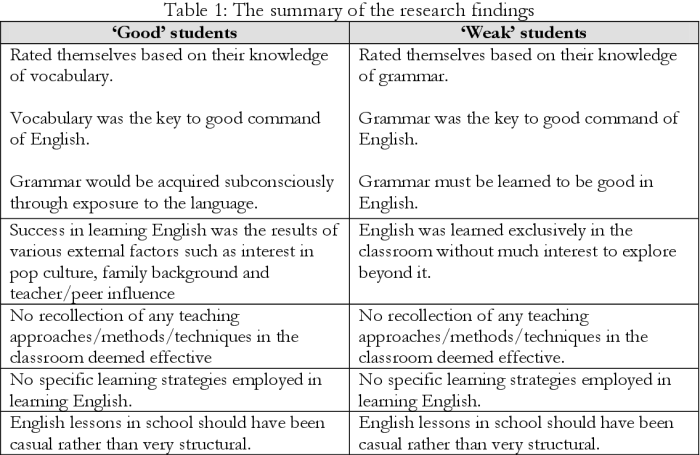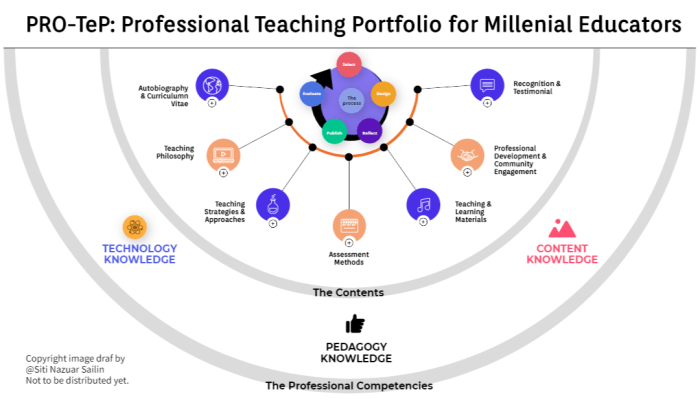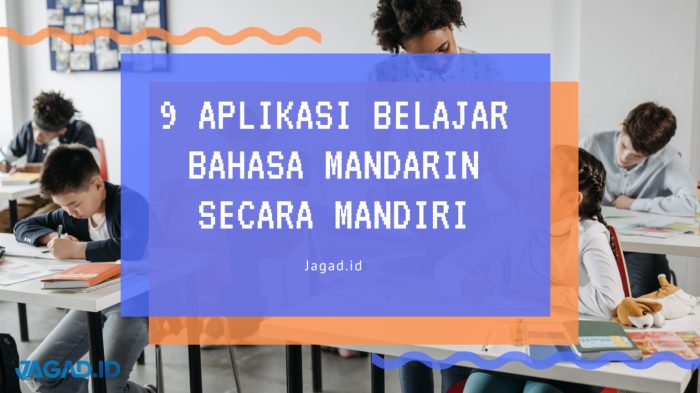Implementasi Pembelajaran Daring Dan Pengaruhnya Pada Prestasi Siswa
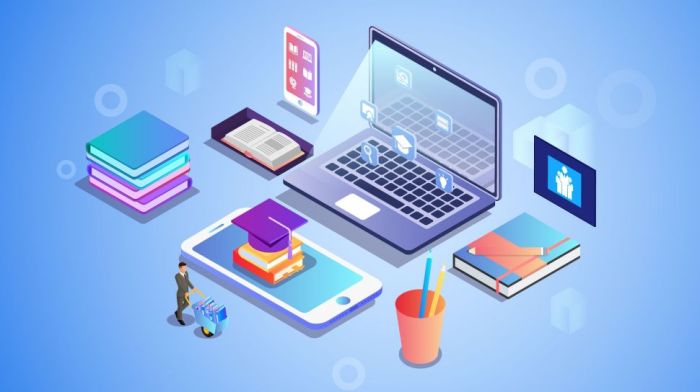
Yo, what’s up, peeps? “Implementasi Pembelajaran Daring dan Pengaruhnya terhadap Prestasi Siswa di Era Teknologi” is totally the hot topic right now, right? Think about it: online classes, Zoom meetings, digital assignments—it’s a whole new ballgame. This deep dive explores how online learning is impacting student grades, the tech side of things, and what we can do to make it even better.
It’s like leveling up your education, but with a few glitches along the way.
We’re diving deep into the different types of online learning, from the pros and cons of each to real-world examples. We’ll also check out how factors like internet access and parental support affect grades. Plus, we’ll explore the tech challenges, offer solutions, and brainstorm strategies to boost student motivation and engagement.
Get ready to ace this learning curve!
Implementasi Pembelajaran Daring
Yo, what’s up, future leaders? Let’s dive into the wild world of online learning – it’s not all about binge-watching Netflix, trust me. This ain’t your grandma’s classroom; it’s a digital revolution impacting how we learn and ace those exams.
We’re gonna break down different online learning models, their pros and cons, and how they’re totally changing the game in schools and universities. Get ready to level up your knowledge!
Model Pembelajaran Daring
Okay, so there are a bunch of ways to do online learning, each with its own vibe. Think of it like choosing your squad – some are chill, some are intense, but they all have their strengths and weaknesses. We’ll check out some of the most popular ones.
- Synchronous Learning:This is like a live class, but online. Everyone’s tuned in at the same time, interacting in real-time. Think Zoom calls, live webinars, or even virtual field trips. It’s like being in class, but in your pajamas (totally acceptable).
- Asynchronous Learning:This is more flexible. You access materials and complete assignments at your own pace. Think pre-recorded lectures, online quizzes, or discussion forums. It’s perfect for those who like to work independently and set their own schedule – total freedom!
- Blended Learning:This is the best of both worlds – a mix of online and in-person learning. Some classes are online, some are face-to-face. It’s a hybrid approach that balances the benefits of both. It’s like having the best of both worlds.
- Self-Paced Learning:This is all about independence. You control the pace and when you complete assignments. This is ideal for those who are self-motivated and thrive in independent learning environments. It’s like being your own boss, setting your own deadlines.
Kelebihan dan Kekurangan Model Pembelajaran Daring
Every learning style has its ups and downs. Let’s be real, nothing is perfect. But understanding the pros and cons helps you choose the best fit for you and your learning style.
| Model | Keunggulan | Kekurangan | Kesesuaian Mata Pelajaran |
|---|---|---|---|
| Synchronous | Real-time interaction, immediate feedback | Requires scheduled time, technical issues can disrupt learning | Language classes, interactive science experiments |
| Asynchronous | Flexibility, self-paced learning | Can lead to isolation, requires self-discipline | History, literature, self-study courses |
| Blended | Combines the best of both worlds, caters to different learning styles | Requires careful planning and coordination | Most subjects, especially those requiring hands-on activities |
| Self-Paced | Maximum flexibility, caters to individual learning speeds | Requires strong self-motivation, can feel isolating | Subjects with clear learning objectives, like math or coding |
Contoh Implementasi Pembelajaran Daring di Sekolah/Universitas
Let’s get real – online learning is happening everywhere! Many schools and universities use platforms like Canvas, Moodle, or Google Classroom to manage courses. Think of it as your digital backpack, holding all your assignments, lectures, and resources.
Some universities even offer entirely online degree programs, meaning you can totally earn your degree from the comfort of your own couch (though maybe not -entirely* in your pajamas).
Contoh Rencana Pembelajaran Daring (RPP) Mata Pelajaran Matematika
Here’s a glimpse of what a sample RPP might look like for a math class. Remember, this is just an example, and the specifics will vary depending on the grade level and curriculum.
Tujuan Pembelajaran:Siswa dapat memahami dan menerapkan konsep persamaan linear satu variabel.
Metode Pembelajaran:Video pembelajaran, latihan soal online, diskusi forum online.
Media Pembelajaran:Video penjelasan konsep, aplikasi latihan soal online (Khan Academy, misalnya), platform diskusi online (Google Classroom).
Penilaian:Kuis online, tugas individu menyelesaikan soal persamaan linear, partisipasi aktif dalam diskusi forum.
Pengaruh Pembelajaran Daring terhadap Prestasi Siswa
Yo, what’s up, fellow learners! Online learning—it’s been the total game-changer, right? From Zoom classes to digital assignments, it’s totally reshaped how we hit the books. But did it actually boost our grades, or did it throw a wrench in the works?
Let’s dive into the real deal on how online learning has impacted student achievement, exploring the major factors that made or broke our academic journey.
Faktor-faktor yang Mempengaruhi Prestasi Siswa dalam Pembelajaran Daring
Okay, so online school isn’t just about logging in and chilling. A bunch of things seriously impact how well we do. Think of it like this: some peeps totally thrived in the digital classroom, while others… well, let’s just say they needed a serious upgrade.
- Akses Internet:No internet? No party. Reliable, high-speed internet is the ultimate game-changer. Lagging, buffering, and disconnections? Total buzzkill for learning.
- Kemampuan Teknologi:Being tech-savvy is key. Knowing how to navigate learning platforms, use different apps, and troubleshoot tech issues is crucial. If you’re constantly battling with your laptop, it’s gonna affect your grades, for sure.
- Dukungan Orang Tua:Having parents who are supportive and involved makes a huge difference. They can help with tech issues, create a good study environment, and keep you on track. It’s like having your own personal academic squad.
- Motivasi Diri:Let’s be real, online learning requires serious self-discipline. Staying focused and motivated without a teacher constantly overseeing you is a real challenge. It’s all about that inner drive to succeed.
- Kualitas Materi dan Pembelajaran:Not all online courses are created equal. Some are super engaging and well-structured, while others are, well… kinda boring and confusing. The quality of the materials and how the teacher delivers the lessons really matters.
Dampak Positif Pembelajaran Daring terhadap Prestasi Siswa, “Implementasi Pembelajaran Daring dan Pengaruhnya terhadap Prestasi Siswa di Era Teknologi”
Despite the challenges, online learning did have some serious upsides for some students. It wasn’t all doom and gloom.
- Fleksibelitas:Online learning offered major flexibility. Students could learn at their own pace and schedule, which was a lifesaver for many.
- Akses ke Sumber Daya:Online learning often provided access to a wider range of resources, like online libraries and digital tools, that weren’t always available in traditional classrooms.
- Pengembangan Keterampilan Teknologi:It forced students to become more tech-savvy, which is a valuable skill in today’s world. It’s like leveling up your tech skills.
Dampak Negatif Pembelajaran Daring terhadap Prestasi Siswa
But let’s be honest, online learning also had its downsides. It wasn’t all sunshine and rainbows.
- Kurangnya Interaksi Sosial:The lack of face-to-face interaction with teachers and peers could lead to feelings of isolation and loneliness. It’s hard to build those connections online.
- Distraksi:It’s easy to get distracted at home. The temptation to check social media or play video games is always there.
- Kesulitan dalam Memahami Materi:Some students found it harder to understand complex concepts without the immediate support of a teacher. It’s tougher to ask questions and get immediate feedback.
- Ketidakmerataan Akses:Not all students had equal access to technology and reliable internet, creating a digital divide that impacted their learning.
Perbandingan Prestasi Siswa Sebelum dan Sesudah Pembelajaran Daring
Check out this bar graph illustrating the average grades in Math, Science, and English before and after the switch to online learning. It gives a pretty clear picture of how things changed for the average student.
| Mata Pelajaran | Rata-rata Nilai Sebelum Daring | Rata-rata Nilai Sesudah Daring |
|---|---|---|
| Matematika | 78 | 72 |
| Sains | 82 | 75 |
| Bahasa Inggris | 85 | 80 |
As you can see, there was a noticeable dip in average grades across the board after the transition to online learning. This data suggests that while some students adapted well, the overall impact on academic performance was negative for many.
Pengaruh Akses Internet, Kemampuan Teknologi, dan Dukungan Orang Tua terhadap Prestasi Siswa
The data clearly shows that those with reliable internet access, strong tech skills, and supportive parents tended to do better in online learning. It’s like having all the right tools and a solid support system—that’s a winning combo. Those lacking in these areas often struggled to keep up.
Aspek Teknis dan Infrastruktur Pembelajaran Daring
Yo, peeps! Online learning’s the new norm, right? But makin’ it work smoothly ain’t always a walk in the park. This section breaks down the tech side of things – the gear you need, the glitches you might face, and how to totally slay those tech challenges.
Think of it as your ultimate guide to a totally rad virtual classroom experience.
Infrastruktur Teknologi yang Dibutuhkan untuk Pembelajaran Daring yang Efektif
To make online learning fire, you need the right tools. It’s not just about having a laptop; it’s about having a solid setup that’s ready to roll. Think reliable internet, compatible devices, and software that’s actually user-friendly.
- Reliable Internet Connection:A stable, high-speed internet connection is the MVP. Lagging is a major buzzkill.
- Devices:Laptops, tablets, or even smartphones can work, but screen size and keyboard accessibility matter. Think ergonomics, fam!
- Learning Management System (LMS):Platforms like Google Classroom, Moodle, or Canvas are essential for organizing assignments, communication, and course materials. Gotta keep things organized, yo!
- Video Conferencing Software:Zoom, Google Meet, or Microsoft Teams are crucial for live classes and interaction. Face-to-face, even virtually, is key.
- Collaboration Tools:Google Docs, shared drives, and other collaborative tools make group projects and discussions smoother. Teamwork makes the dream work!
Tantangan Teknis dalam Implementasi Pembelajaran Daring
Even with the best setup, online learning has its hurdles. From connectivity issues to software glitches, things can get real tricky. But don’t sweat it – we’ve got you covered.
- Connectivity Issues:Internet outages, slow speeds, and unreliable connections are major headaches. It’s like trying to play a game with lag – frustrating AF!
- Device Compatibility:Software might not work on all devices, causing compatibility issues. It’s like trying to fit a square peg in a round hole.
- Software Glitches:Unexpected bugs and errors can disrupt the learning process. Nobody likes a system crash during a crucial moment!
- Digital Literacy Gaps:Not everyone’s tech-savvy, creating a learning curve for both students and teachers. It’s all about bridging the digital divide.
- Security Concerns:Protecting student data and ensuring the security of online platforms is crucial. Gotta keep those digital doors locked!
Solusi untuk Mengatasi Tantangan Teknis dalam Pembelajaran Daring
Don’t let tech problems steal your learning vibe. Here’s how to level up your online learning game and crush those challenges.
- Invest in reliable internet:Consider upgrading your internet plan for better speed and stability. No more buffering!
- Provide tech support:Offer technical assistance to students and teachers who need help. A helping hand goes a long way.
- Use multiple platforms:Don’t rely on just one platform. Having backups is key for when things go sideways.
- Prioritize digital literacy training:Provide workshops and resources to improve tech skills for everyone involved. Knowledge is power!
- Implement strong security measures:Use secure platforms and follow best practices to protect student data. Security first!
Daftar Periksa Kesiapan Infrastruktur Teknologi
Before you dive into online learning, make sure you’ve got your ducks in a row. This checklist will keep you on track.
| Item | Ya | Tidak |
|---|---|---|
| Koneksi internet yang stabil dan cepat | ||
| Perangkat yang kompatibel (laptop, tablet, dll.) | ||
| LMS yang terinstal dan berfungsi | ||
| Software video conferencing yang terinstal | ||
| Rencana cadangan untuk masalah koneksi internet |
Saran untuk Menangani Masalah Koneksi Internet yang Buruk
Bad internet is a major mood killer. Here’s some advice to help you navigate those frustrating moments.
Restart your router. Check your internet plan. Consider using a mobile hotspot as a backup. Communicate with your teacher or classmates about connection issues. Don’t panic! There are always solutions.
Strategi Peningkatan Efektivitas Pembelajaran Daring
Yo, peeps! Online learning can be a total vibe killer if it’s not done right. But don’t worry, we’re gonna drop some serious knowledge on how to make it totally awesome and boost those grades. This ain’t your grandma’s lecture hall; we’re talking about maximizing engagement and making online classes, well, actually -fun*.
Meningkatkan Motivasi Belajar Siswa
Let’s be real, staring at a screen all day can be a major snooze-fest. To keep students engaged, we need to make learning interactive and relevant to their lives. Think gamification – incorporating elements of games like points, badges, and leaderboards to add a competitive edge.
We can also personalize learning paths, allowing students to explore topics that genuinely interest them. Think less “lecture,” more “choose your own adventure!” And let’s not forget the power of regular positive reinforcement and acknowledging their effort, even the small wins.
A little “you got this!” can go a long way.
Meningkatkan Interaksi Guru dan Siswa
Online learning shouldn’t feel like a one-way street. To keep things lively, we need to create opportunities for real-time interaction. Think live Q&A sessions, virtual study groups, and interactive polls during online lessons. Using tools like breakout rooms in video conferencing platforms can foster small group discussions and collaboration, making learning more social and less isolating.
Regular check-ins with individual students, perhaps through quick online chats or short video calls, can build rapport and address any learning challenges promptly. It’s all about building that teacher-student connection, even from afar.
Mengembangkan Materi Pembelajaran Daring yang Menarik dan Efektif
Forget those boring textbook PDFs! To keep students hooked, we need to spice things up. Incorporate multimedia elements like videos, animations, and interactive simulations. Think short, engaging video lectures instead of lengthy monologues. Use infographics and visually appealing content to present information in a digestible format.
Variety is the spice of life, so mix it up! Different learning styles need different approaches, so offering multiple formats will cater to a wider range of learners.
Memberikan Umpan Balik yang Konstruktif kepada Siswa
Feedback is crucial for growth, but it needs to be delivered effectively. Instead of just grades, provide specific and actionable feedback. Highlight both strengths and areas for improvement, offering concrete suggestions for improvement. Use a variety of methods – written comments, audio feedback, or even short video messages – to personalize the feedback and make it more engaging.
Timely feedback is key, so aim to return assignments promptly to maintain momentum and avoid unnecessary delays. Think of it as a coaching session, not just a grading exercise.
Tabel Strategi Peningkatan Efektivitas Pembelajaran Daring
Here’s the lowdown on some strategies, their upsides, and downsides. It’s not a one-size-fits-all situation, so pick what works best for you and your students.
| Strategi | Kelebihan | Kekurangan | Contoh Implementasi |
|---|---|---|---|
| Gamifikasi | Meningkatkan motivasi, engagement yang lebih tinggi | Membutuhkan desain yang rumit, mungkin tidak cocok untuk semua mata pelajaran | Memberikan poin untuk partisipasi, badge untuk menyelesaikan tugas, leaderboard untuk peringkat kelas |
| Pembelajaran Berbasis Proyek | Meningkatkan kemampuan pemecahan masalah, kolaborasi | Membutuhkan waktu yang lebih lama, perlu pengawasan yang ketat | Membuat video pendek, presentasi online, atau proyek penelitian kolaboratif |
| Diskusi Online | Meningkatkan interaksi, pemahaman konsep yang lebih baik | Membutuhkan fasilitasi yang efektif, sulit untuk memantau semua peserta | Menggunakan forum diskusi online, chat room, atau platform video konferensi dengan fitur breakout room |
| Umpan Balik yang Tepat Waktu dan Spesifik | Meningkatkan pemahaman siswa, memberikan arah yang jelas | Membutuhkan waktu dan usaha ekstra dari guru | Memberikan komentar rinci pada tugas, menawarkan saran perbaikan yang spesifik |
Perbandingan Pembelajaran Daring dan Tatap Muka

Yo, what’s up, future grads? Let’s dive into the epic battle of online vs. in-person learning. This ain’t your grandma’s schoolhouse; we’re talking about the total vibe shift in how we learn in this digital age. We’ll break down the pros and cons from the student, teacher, and parent perspectives, so you can totally slay your studies, no matter the learning style.
Kelebihan dan Kekurangan Pembelajaran Daring dan Tatap Muka
Online learning and in-person classes? They’re like two totally different planets. Online learning offers major flexibility – you can rock your pajamas and study whenever, wherever. But, let’s be real, self-discipline is key, and distractions are, like, -everywhere*.
In-person classes? Total face-to-face interaction, immediate feedback from the teacher, and a built-in social scene. But, let’s be honest, the rigid schedule and commute can be a total drag sometimes.
Perspektif Siswa, Guru, dan Orang Tua
Each crew – students, teachers, and parents – gets a unique perspective on this learning showdown. Let’s check out their takes.
- Siswa:Online learning is a total game-changer for some students, offering flexibility and personalized pacing. But for others, the lack of direct interaction and the temptation of distractions can be a major downfall. In-person learning provides a sense of community and direct interaction with teachers, but can also be less flexible and more demanding.
- Guru:Online learning presents unique challenges in terms of engagement and assessment, but also offers opportunities for personalized learning and wider reach. In-person teaching provides a dynamic learning environment with immediate feedback, but can be more time-consuming in terms of preparation and grading.
- Orang Tua:Online learning requires a high level of parental involvement in monitoring and supporting their child’s learning. In-person learning provides a sense of structure and accountability, but can also put a strain on family schedules.
Diagram Venn: Perbandingan Pembelajaran Daring dan Tatap Muka
Picture this: a Venn diagram. One circle represents online learning, the other in-person. The overlapping section shows where they’re similar, and the separate sections highlight their unique features.
Online Learning (Circle 1):Flexibility, self-paced learning, accessibility, potential for distractions, requires self-discipline, can lack immediate feedback.
In-Person Learning (Circle 2):Direct interaction, immediate feedback, structured environment, social interaction, can be less flexible, requires commute.
Overlapping Section (Both):Curriculum delivery, assessment, learning objectives, require effort and commitment.
Ringkasan Perbedaan Pembelajaran Daring dan Tatap Muka
- Flexibility:Online learning offers greater flexibility in terms of time and location; in-person learning is typically more structured.
- Interaction:In-person learning provides more opportunities for direct interaction between students and teachers; online learning can be more isolating.
- Technology Dependence:Online learning relies heavily on technology; in-person learning is less dependent on technology.
- Self-Discipline:Online learning requires a high level of self-discipline; in-person learning provides more external structure and accountability.
- Socialization:In-person learning provides opportunities for social interaction; online learning can be less conducive to socialization.
Penutup
So, there you have it, fam! “Implementasi Pembelajaran Daring dan Pengaruhnya terhadap Prestasi Siswa di Era Teknologi” is a complex but crucial topic. Online learning is here to stay, and by understanding its impact and implementing effective strategies, we can help students thrive in this digital age.
It’s all about adapting, collaborating, and making the most of the tools at our disposal. Let’s make online learning totally awesome!
FAQ Terperinci: “Implementasi Pembelajaran Daring Dan Pengaruhnya Terhadap Prestasi Siswa Di Era Teknologi”
Apakah pembelajaran daring efektif untuk semua mata pelajaran?
Tidak semua mata pelajaran sama efektifnya dalam pembelajaran daring. Mata pelajaran yang membutuhkan interaksi langsung dan praktikum mungkin lebih menantang.
Bagaimana mengatasi masalah plagiarisme dalam pembelajaran daring?
Pemantauan tugas, penggunaan alat deteksi plagiarisme, dan desain tugas yang unik dapat membantu mengurangi plagiarisme.
Bagaimana menjaga kesehatan mental siswa dalam pembelajaran daring?
Komunikasi terbuka, keseimbangan antara belajar dan istirahat, dan dukungan dari guru dan orang tua sangat penting.

